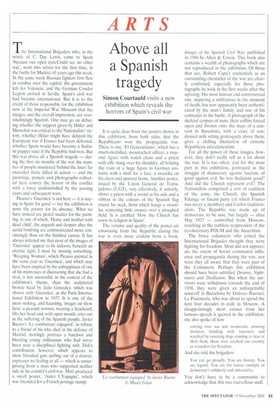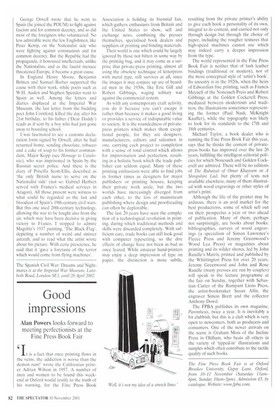Above all a Spanish tragedy
Simon Courtauld visits a new exhibition which reveals the horrors of Spain's civil war The International Brigaders who, in the words of C. Day Lewis, came to Spain 'because our open eyes/Could see no other way', went into action for the first time, in the battle for Madrid, 65 years ago this week. In the same week Russian fighters first flew in combat over the capital, the government left for Valencia, and the German Condor Legion arrived in Seville. Spain's civil war had become international. But it is to the credit of those responsible for the exhibition now at the Imperial War Museum that the images, and the overall impression, are overwhelmingly Spanish. One may go on debating whether the support given by Hitler and Mussolini was critical to the Nationalists' victory. whether Hitler might have delayed the European war if Franco had been defeated, whether Spain would have become a Stalinist puppet state if the Republic had won. But this was above all a Spanish tragedy — during the first six months of the war the number of people murdered 'behind the lines' far exceeded those killed in action — and the paintings, posters and photographs collected here convey the horror of the conflict with a force undiminished by the passing years and subsequent wars.
Picasso's 'Guernica' is not here — it is staying in Spain for good — but the exhibition is none the poorer for its absence. What we have instead are pencil studies for the painting, in one of which, `Horse and mother with dead child', the anguish and despair after the aerial bombing are communicated more convincingly than on the finished canvas. It has always irritated me that most of the images of `Guernica' appear to be indoors, beneath an electric light; I must be missing something. `Weeping Woman', which Picasso painted in the same year as Guernica', and which may have been inspired by the unhappiness of one of his mistresses at discovering that she had a rival, is less successful, in the context of the exhibition's theme, than the sculptured bronze head by Julio Gonzalez, which was shown, with 'Guernica', at the Paris International Exhibition in 1937. It is one of the most striking, and haunting, images on show here: a peasant woman, wearing a headscarf, lifts her head and, with open mouth, cries out at the suffering of the Spanish people. Javier Buenos 'Le combattant espagnol', in tribute to a friend of his who died in the defence of Madrid, movingly portrays a barefoot and bleeding young militiaman who had never been near a disciplined fighting unit. DaIfs contribution, however, which appears to show bloodied guts spilling out of a drawer, expresses no feeling at all — which is unsurprising from a man who supported neither side in his country's civil war. Mire, produced a small poster, 'Aidez L'Espagne', which was intended for a French postage stamp. It is quite clear from the posters shown in this exhibition, from both sides, that the Republicans won the propaganda war. There is one, 'El Generalisimo', which has a much-medalled, moustached officer, a mayoral figure with watch chain and a priest with rifle slung over his shoulder, all holding the train of a huge figure in German uniform, with a skull for a face, a swastika on his chest and spurred boots. Another poster, issued by the Union General de Trabajadores (UGT), very effectively, if unfairly, shows a priest with a sword at his side and a ribbon in the colours of the Spanish flag round his neck, from which hangs a swastika, scattering little crosses over a ploughed field. It is entitled 'How the Church has sown its religion in Spain'.
The volume and quality of the poster art emanating from the Republic during the war is even more evident from a book, Images of the Spanish Civil War, published in 1986 by Allen & Unwin. This book also contains a wealth of photographs which are not reproduced in the exhibition. Of those that are, Robert Capa's credentials as an outstanding chronicler of the war are clearly confirmed, especially for those photographs he took in the first weeks after the uprising. His most famous and controversial one, depicting a militiaman in the moment of death, has now apparently been authenticated by the man's family and one of his comrades in the battle. A photograph of the skeletal corpses of nuns, their coffins forced open and thrown onto the steps of a convent in Barcelona, with a crate of condensed milk sitting grotesquely above them, gives a chilling illustration of extreme Republican anti-clericalism.
For all the power of these images, however, they don't really tell us a lot about the war. It is too often, and for the most part in this exhibition, portrayed as the struggle of democracy against fascism, of good against evil. So was Stalinism good? And did the Church represent evil? The Nationalists comprised a sort of coalition of the army, the Church, the Spanish Falange or fascist party (of which Franco was never a member) and Carlist traditionalists. The Republic was made up of democrats, to be sure, but largely — after May 1937 — controlled from Moscow, resulting in the ruthless suppression of the revolutionary POUM and the Anarchists.
The brave volunteers who joined the International Brigades thought they were fighting for freedom. Most did not appreciate the extent of Soviet communist influence and propaganda during the war, nor were they all aware that they were part of the Comintern. Perhaps this exhibition should have been subtitled Dreams, Nightmares and Disillusion. But when the survivors were withdrawn towards the end of 1938, they were given an unforgettable send-off in Barcelona by Dolores Ibarruri, La Pasionaria, who was about to spend the next four decades in exile in Moscow. A disappointingly short extract from her famous speech is quoted in the exhibition: she also spoke of how coming over sea and mountains, crossing frontiers bristling with bayonets and watched by ravening dogs wanting to tear at their flesh, these men reached our country as crusaders for freedom.
And she told the brigaders: You can go proudly. You are history. You are legend. You are the heroic example of democracy's solidarity and universality.
You don't have to be a communist to acknowledge that this was marvellous stuff. George Orwell wrote that he went to Spain (he joined the POUM) to fight against fascism and for common decency, and so did most of the foreigners who volunteered. No less admirable were the few Englishmen, like Peter Kemp, on the Nationalist side who were fighting against communism and for common decency. But the Republic had the propaganda, it honoured intellectuals, unlike the Nationalists, and as the fascist menace threatened Europe, it became a great cause.
In England Henry Moore, Benjamin Britten and Samuel Barber supported the cause with their work, while poets such as W.H. Auden and Stephen Spender went to Spain as well. Among the letters and diaries displayed at the Imperial War Museum, the last letter from the budding poet John Cornford, killed the day after his 21st birthday, to his father (Dear Daddy') reads as if sent by a boy who had just gone away to boarding school.
I was fascinated to see a customs declaration form signed by Orwell, after he had returned home, sending chocolate, tobacco and a cake of soap to his former commandant, Major Kopp (see Homage to Catalonia), who was imprisoned in Spain by the Russian secret police. And there is the diary of Priscilla Scott-Ellis, described as 'the only British nurse to serve on the Nationalist side' (not so: Gabriel Herbert served with Franco's medical services in Aragon). All those present were witness to what could be regarded as the last and bloodiest of Spain's 19th-century civil wars. But this one used 20th-century technology, allowing the war to be fought also from the air, which may have been decisive in giving victory to Franco. I stopped to admire Magritte's 1937 painting, The Black Flag', depicting a number of weird and sinister aircraft, and to read what the artist wrote about his picture. With eerie prescience, he said that it 'gave a foretaste of the terror which would come from flying machines'.
The Spanish Civil War: Dreams and Nightmares is at the Imperial War Museum, Lambeth Road, London SE1, until 28 April 2002.















































































































 Previous page
Previous page